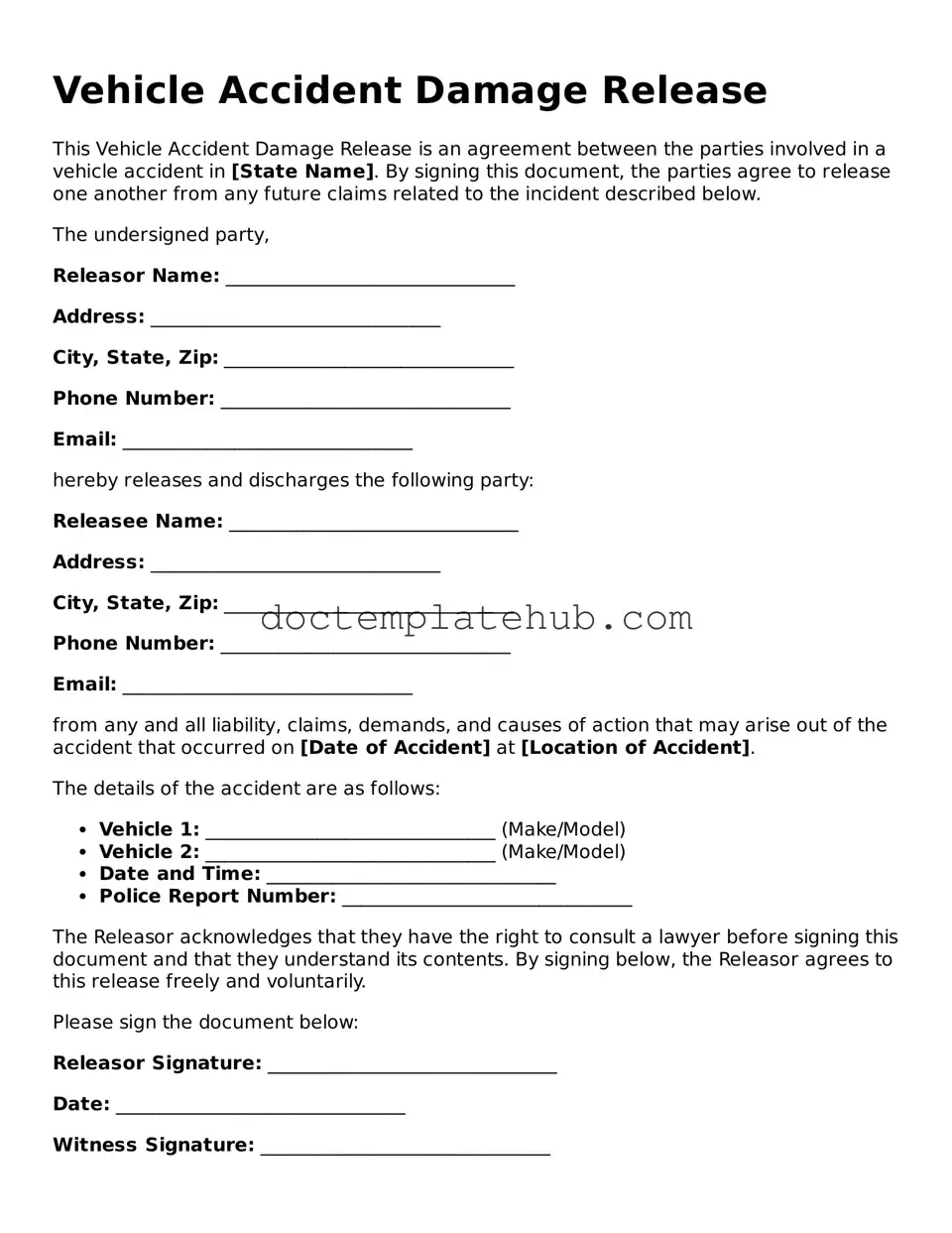The Vehicle Accident Damage Release form is similar to a general Release of Liability form. Both documents serve to protect one party from legal claims arising from an incident. In a Release of Liability, the injured party agrees not to hold the other party responsible for any injuries or damages that may occur, effectively waiving their right to sue. This document is often used in various contexts, such as sports activities or recreational events, where participants acknowledge the risks involved.
Another document akin to the Vehicle Accident Damage Release form is the Settlement Agreement. This agreement outlines the terms under which one party agrees to compensate another for damages incurred. Like the release form, a Settlement Agreement often includes a clause that prevents further claims related to the same incident. It provides a clear resolution to disputes and helps both parties move forward without the threat of ongoing litigation.
The Non-Disclosure Agreement (NDA) shares similarities with the Vehicle Accident Damage Release form in that both documents involve the protection of sensitive information. While an NDA focuses on confidentiality, a release form addresses the relinquishing of claims. In both cases, parties enter into a legal understanding that limits future actions based on the terms outlined in the document.
The Indemnity Agreement also parallels the Vehicle Accident Damage Release form. This document allows one party to compensate another for any losses or damages incurred. In essence, it shifts the financial responsibility from one party to another, much like how the release form waives the right to pursue damages. Both documents aim to clarify responsibilities and minimize potential disputes.
In the realm of insurance, the Proof of Loss form is another document that bears resemblance to the Vehicle Accident Damage Release form. This form is used to report a loss to an insurance company and initiate a claim. While the release form may finalize a claim, the Proof of Loss establishes the basis for it. Both documents serve to ensure that parties acknowledge and document the circumstances surrounding a loss or damage.
The Waiver of Subrogation is also comparable to the Vehicle Accident Damage Release form. This waiver prevents an insurance company from pursuing a third party for reimbursement after paying a claim. Similar to the release form, it is designed to limit future claims and protect certain parties from legal actions. Both documents are tools to manage risk and liability in various situations.
The Hold Harmless Agreement shares common ground with the Vehicle Accident Damage Release form. In this agreement, one party agrees not to hold another party responsible for any damages or injuries that may arise from a specific activity or event. Both documents aim to mitigate risk and clarify the responsibilities of each party involved, fostering a clearer understanding of liability.
The Consent to Treat form, often used in medical settings, is similar in that it involves the acknowledgment of risks. Patients sign this form to grant healthcare providers permission to administer treatment. Like the Vehicle Accident Damage Release form, it requires individuals to accept certain risks and relinquish the right to claim damages related to the treatment provided.
Understanding the various legal documents related to accidents, such as the Vehicle Accident Damage Release form, can significantly influence how liability is perceived and managed. For instance, utilizing a OnlineLawDocs.com resource can provide valuable insights into the appropriate forms like the Release of Liability, enhancing the clarity for all parties involved in the claims process.
The Assignment of Benefits form is another document that aligns with the Vehicle Accident Damage Release form. This form allows an individual to transfer their insurance benefits to a service provider. Both documents involve the relinquishment of certain rights, with the Assignment of Benefits focusing on financial claims and the release form addressing liability in the context of an accident.
Lastly, the Release of Claims form is directly comparable to the Vehicle Accident Damage Release form. This document explicitly states that one party releases another from any future claims related to a specific incident. Both forms serve to finalize agreements between parties, ensuring that all claims are settled and preventing future legal disputes arising from the same circumstances.
